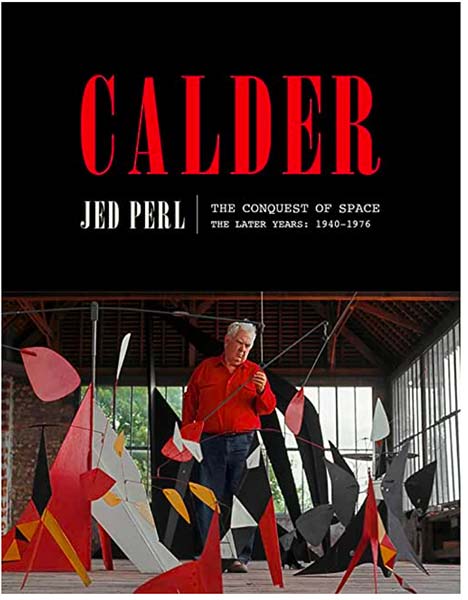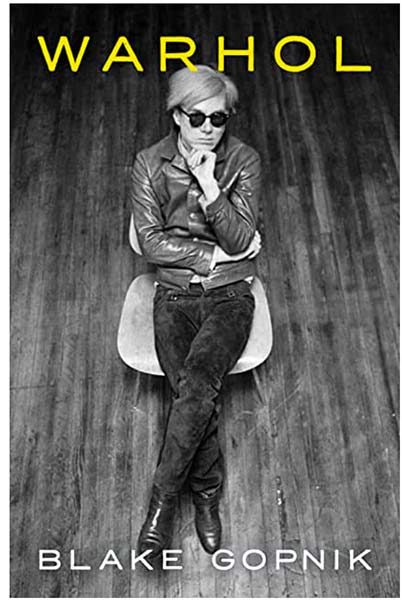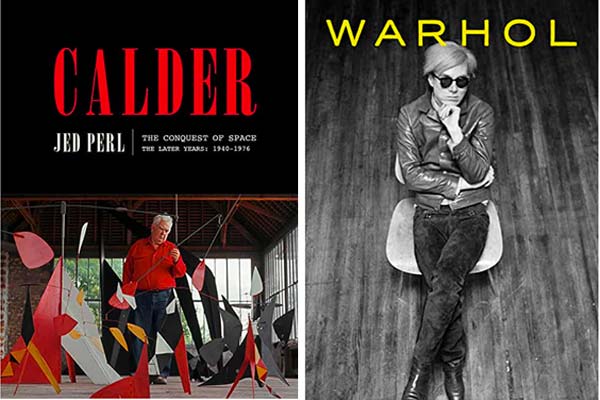Two Biographies Inform Each Other
By Martin Mugar, WTP Guest Writer
Reading Calder: The Conquest of Time required an adjustment of my habitual expectations of the reading of Jed Perl’s writing. I always enjoy his incisive critique and deflation of the art “powers that be.” I have spoken with many artists who are part of his fandom. We all seem to suffer in silence from the exclusivity of the art world with Perl our sole public voice. I wonder if they found it difficult to read a book by Perl that is unequivocally enthusiastic about its subject.
 As I began to think about finishing my reading and reviewing Jed Perl’s monumental second volume Calder: The Conquest of Space, the art world was inundated by the responses to the publication of Blake Gopnik’s thousand page book on Warhol. I gathered from a few exchanges with Gopnik online that he sees the media-saturated work of Warhol and Koons as the incontrovertible art of the present and in that sense, world changing. The edge between mass culture and the individual has broken down, and this duo with their philosophically hip intersubjectivity are defining the present and are the wave of the future.
As I began to think about finishing my reading and reviewing Jed Perl’s monumental second volume Calder: The Conquest of Space, the art world was inundated by the responses to the publication of Blake Gopnik’s thousand page book on Warhol. I gathered from a few exchanges with Gopnik online that he sees the media-saturated work of Warhol and Koons as the incontrovertible art of the present and in that sense, world changing. The edge between mass culture and the individual has broken down, and this duo with their philosophically hip intersubjectivity are defining the present and are the wave of the future.
I came away from these most recent books by both Gopnik and Perl with a vision of two worlds diametrically opposed; on the one hand, we have Calder who has uploaded the modernistic visual language of Miro to his mobile work, and in so doing, redefined the modern art experience—kinetics now translates into stabile sculpture occupying public spaces in the new urban landscape. On the other hand, you have Warhol downloading the images of mass culture into his consciousness and calling them high art. To make that claim requires acknowledging the dominance of mass visual media. It is in a sense reactionary, a parallel distinction between the flat screen of painting and the flat screen of media. Nothing can be more antipodal to Calder who explodes the flat images of Miro into mobile 3D imagery. It is a continuation of the modernist vision of transforming our science-based notion of space and time started by the cubists.
At the very beginning of Perl’s second volume, he describes the events leading up to the installation of the stabile “Grande Vitesse” in Grand Rapids Michigan. Calder’s work seems to parallel the architectural transformation of the urban scene so as to create a kind of urban space starting in the 1950s perfectly adapted to Calder’s work. There was a newfound pride in the city that created sufficient wealth to replace the antiquated landscape of nineteenth-century America with a sleek new modernism. Although the industrialists were for the most part pedestrian in their artistic tastes, in the case of Grand Rapids, one town father was married to an artistic sophisticate Nancy Mulnix who had been aware of Calder’s work early in her life and was an aficionado of modernism at a time when a taste for its subversive ideas was not shared by the general public.
Perl reminds us that the world out of which Calder’s work came was defined by the writings of Joyce, the art of Picasso, the music of Stravinsky, and the dance of Balanchine. At mid-century this was still the avantgarde. As the old nineteenth-century Grand Rapids succumbed to urban renewal and the nineteenth-century city hall, despite protests from a public coming to appreciate the old just as it was being destroyed, a new city hall was being designed by Skidmore, Owings & Merrill. The building that might have looked impressive if it was on the scale of a New York City skyscraper comes across as a rather squat low budget expression of the modernist spirit.
 After some research on the Vandenberg Plaza now commonly called the Calder Plaza, I found that few citizens are pleased with the outcome of the urban renewal of a half century ago. Much nostalgia is expressed toward the destroyed city hall. However, the disappointment over the antiseptic urban space does not extend to the Calder, which is for the most part admired and appreciated on its artistic merit. The high tide of modernism left its mark with numerous Calder’s throughout the Urban landscape.
After some research on the Vandenberg Plaza now commonly called the Calder Plaza, I found that few citizens are pleased with the outcome of the urban renewal of a half century ago. Much nostalgia is expressed toward the destroyed city hall. However, the disappointment over the antiseptic urban space does not extend to the Calder, which is for the most part admired and appreciated on its artistic merit. The high tide of modernism left its mark with numerous Calder’s throughout the Urban landscape.
What intrigues me is the lifespan of artistic ideas from their inception and to their waning. Perl does a marvelous and painstaking job contact tracing ideas of Calder and the avant-garde of the time. Man Ray is the only other American I can think of who played as successfully in the transatlantic stage of modernism as did Calder.
Although Calder was not a theorist and kept his ideas to himself, Calder’s world seemed to function on the belief that ideas matter and that his work was destined to be the vehicle for a new expression of time and space. The ball that is being passed around on its way to the stabiles started out with Miro. One sees its effect on Gorky. So dominant and salient is his influence, Perl at one point in the book wonders if Calder, who was a neighbor of Gorky in Connecticut, had influenced Gorky’s late work. Maybe so, but a case could be made for the parallel influence and evolution of Miro on both their oeuvres. And the ideas embodied in Calder’s work are embedded in our day-to-day life. The most salient example are the mobiles as the conceptual basis for crib toys. Mondrian and de Stijl impacted architecture and fashion, but to have transformed the experience of a child’s first years of life is quite astounding.
Calder’s life is nothing short of a never-ending story of successfully achieving venues for his work and the best critical response. The successes come from the start: being born to a family of artists who provided important career connections; a perfect marriage; meeting up with the French avant-garde at the right time; joining the transatlantic artistic aristocracy; and toward the end of his life achieving a near total conquest of the world of public sculpture in the United States and Europe. The only way to read this biography is to go along for the ride. Perl has provided not only the large arcs of that life but the infinitesimal detail.
The strange disconnect of this glorious life and work and its seamless embodiment of a positivistic scientific understanding of time and space seems distant from our postmodern times. A large majority of what is exhibited manifests the societal critique of the self, caught in the web of a societal construct whether it is shaped by a notion of Marxist false consciousness or the pandemic of social media. This is Warhol’s era. Cynically Ironic. Power hungry. No wonder that Warhol and Trump were both mentored by Joe McCarthy’s lawyer Roy Cohn.
Martin Mugar’s work has been included in numerous group shows, and in solo exhibitions at the Creiger Dane Gallery, The Bromfield Gallery and the MIT Museum, in Boston, and frequently at the Bowery Gallery in New York City, among others. It is also included in the public collections of The Weatherspoon Museum, The Danforth Museum, The Boston Public Library, Tufts University Museum, The Fuller Museum, Merrimack College and Simmons College. He received his BA cum laude from Yale College in 1971 and his MFA from Yale University in 1974. He has taught at the University of North Carolina, the University of New Hampshire, Dartmouth College, and the Art Institute of Boston. In 2019 he published Drawing and Painting: Perceptual theory as a basis for learning how to draw, a textbook informed by Mugar’s extensive experience teaching.

